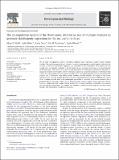| dc.contributor.author | Wahl, Mary E. | |
| dc.contributor.author | Hahn, Julie | |
| dc.contributor.author | Gora, Kasia G. | |
| dc.contributor.author | Davidson, Eric H. | |
| dc.contributor.author | Oliveri, Paola | |
| dc.date.accessioned | 2015-03-20T18:32:51Z | |
| dc.date.available | 2015-03-20T18:32:51Z | |
| dc.date.issued | 2009-11 | |
| dc.date.submitted | 2009-07 | |
| dc.identifier.issn | 00121606 | |
| dc.identifier.issn | 1095-564X | |
| dc.identifier.uri | http://hdl.handle.net/1721.1/96139 | |
| dc.description.abstract | The genomic cis-regulatory systems controlling regulatory gene expression usually include multiple modules. The regulatory output of such systems at any given time depends on which module is directing the function of the basal transcription apparatus, and ultimately on the transcription factor inputs into that module. Here we examine regulation of the Strongylocentrotus purpuratus tbrain gene, a required activator of the skeletogenic specification state in the lineage descendant from the embryo micromeres. Alternate cis-regulatory modules were found to convey skeletogenic expression in reporter constructs. To determine their relative developmental functions in context, we made use of recombineered BAC constructs containing a GFP reporter and of derivatives from which specific modules had been deleted. The outputs of the various constructs were observed spatially by GFP fluorescence and quantitatively over time by QPCR. In the context of the complete genomic locus, early skeletogenic expression is controlled by an intron enhancer plus a proximal region containing a HesC site as predicted from network analysis. From ingression onward, however, a dedicated distal module utilizing positive Ets1/2 inputs contributes to definitive expression in the skeletogenic mesenchyme. This module also mediates a newly discovered negative Erg input which excludes non-skeletogenic mesodermal expression. | en_US |
| dc.description.sponsorship | California Institute of Technology (SURF Program) | en_US |
| dc.description.sponsorship | California Institute of Technology (Camilla Chandler Frost Fellowship) | en_US |
| dc.description.sponsorship | United States. Dept. of Defense (National Defense Science and Engineering Graduate Fellowship) | en_US |
| dc.description.sponsorship | National Institutes of Health (U.S.) (NIH grant HD037105) | en_US |
| dc.description.sponsorship | National Institutes of Health (U.S.) (grant GM075089) | en_US |
| dc.language.iso | en_US | |
| dc.publisher | Elsevier B.V. | en_US |
| dc.relation.isversionof | http://dx.doi.org/10.1016/j.ydbio.2009.08.005 | en_US |
| dc.rights | Article is made available in accordance with the publisher's policy and may be subject to US copyright law. Please refer to the publisher's site for terms of use. | en_US |
| dc.source | Elsevier | en_US |
| dc.title | The cis-regulatory system of the tbrain gene: Alternative use of multiple modules to promote skeletogenic expression in the sea urchin embryo | en_US |
| dc.type | Article | en_US |
| dc.identifier.citation | Wahl, Mary E., Julie Hahn, Kasia Gora, Eric H. Davidson, and Paola Oliveri. “The Cis-Regulatory System of the Tbrain Gene: Alternative Use of Multiple Modules to Promote Skeletogenic Expression in the Sea Urchin Embryo.” Developmental Biology 335, no. 2 (November 2009): 428–441. © 2009 Elsevier Inc. | en_US |
| dc.contributor.department | Massachusetts Institute of Technology. Department of Biology | en_US |
| dc.contributor.mitauthor | Gora, Kasia G. | en_US |
| dc.relation.journal | Developmental Biology | en_US |
| dc.eprint.version | Final published version | en_US |
| dc.type.uri | http://purl.org/eprint/type/JournalArticle | en_US |
| eprint.status | http://purl.org/eprint/status/PeerReviewed | en_US |
| dspace.orderedauthors | Wahl, Mary E.; Hahn, Julie; Gora, Kasia; Davidson, Eric H.; Oliveri, Paola | en_US |
| dspace.mitauthor.error | true | |
| mit.license | PUBLISHER_POLICY | en_US |
| mit.metadata.status | Complete | |
